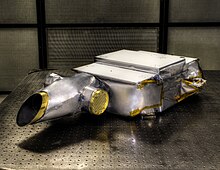
Back Infrarooispektroskopie Afrikaans مطيافية الأشعة تحت الحمراء Arabic Инфрачервена спектроскопия Bulgarian Espectroscòpia infraroja Catalan Infračervená spektroskopie Czech Infrarød spektroskopi Danish Infrarotspektroskopie German Φασματοσκοπία υπερύθρου Greek Espectroscopía infrarroja Spanish Infrapunaspektroskoopia Estonian

Infrared spectroscopy (IR spectroscopy or vibrational spectroscopy) is the measurement of the interaction of infrared radiation with matter by absorption, emission, or reflection. It is used to study and identify chemical substances or functional groups in solid, liquid, or gaseous forms. It can be used to characterize new materials or identify and verify known and unknown samples. The method or technique of infrared spectroscopy is conducted with an instrument called an infrared spectrometer (or spectrophotometer) which produces an infrared spectrum. An IR spectrum can be visualized in a graph of infrared light absorbance (or transmittance) on the vertical axis vs. frequency, wavenumber or wavelength on the horizontal axis. Typical units of wavenumber used in IR spectra are reciprocal centimeters, with the symbol cm−1. Units of IR wavelength are commonly given in micrometers (formerly called "microns"), symbol μm, which are related to the wavenumber in a reciprocal way. A common laboratory instrument that uses this technique is a Fourier transform infrared (FTIR) spectrometer. Two-dimensional IR is also possible as discussed below.
The infrared portion of the electromagnetic spectrum is usually divided into three regions; the near-, mid- and far- infrared, named for their relation to the visible spectrum. The higher-energy near-IR, approximately 14,000–4,000 cm−1 (0.7–2.5 μm wavelength) can excite overtone or combination modes of molecular vibrations. The mid-infrared, approximately 4,000–400 cm−1 (2.5–25 μm) is generally used to study the fundamental vibrations and associated rotational–vibrational structure. The far-infrared, approximately 400–10 cm−1 (25–1,000 μm) has low energy and may be used for rotational spectroscopy and low frequency vibrations. The region from 2–130 cm−1, bordering the microwave region, is considered the terahertz region and may probe intermolecular vibrations.[1] The names and classifications of these subregions are conventions, and are only loosely based on the relative molecular or electromagnetic properties.
© MMXXIII Rich X Search. We shall prevail. All rights reserved. Rich X Search